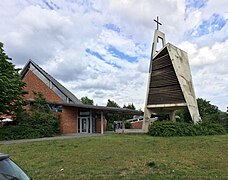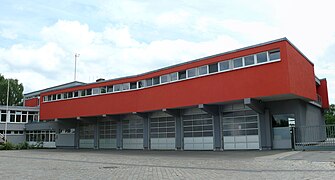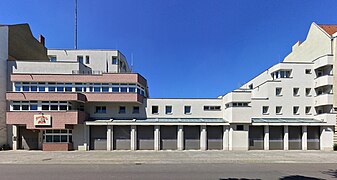Bodo Fleischer
Bodo Fleischer (born November 7, 1930 in Berlin ; † February 18, 2013 there ) was a German architect .
Life
Fleischer studied architecture at the Technical University of Berlin from 1949 and there acquired the academic degree of graduate engineer in 1955 . Hans Scharoun was one of his teachers. Fleischer was then from 1955 to 1960 as a research assistant of Bernhard Hermkes hired at the Department of Design, Construction and Industrial, having the same chair already as a student assistant for Hermkes' predecessor - Hans Hertlein had worked -.
Fleischer realized buildings for supply, administration and living as well as sacred buildings in Berlin. In Pforzheim , the city theater (1979–1988) was built according to his plans. Fleischer is known primarily for church buildings and fire stations (e.g. Suarezstrasse fire station , 1971–1974) and the Eva-Maria-Buch-Haus of the Tempelhof-Schöneberg City Library (1975–1978) on Götzstrasse in Berlin-Tempelhof. Two of Fleischer's buildings that shape Berlin's cityscape are the workers' dormitory at Neue Heimat on the corner of Kulmer Strasse and Goebenstrasse (1969–1970) and the AOK administration building on Mehringplatz, which Fleischer planned in collaboration with Scharoun (1967–1970). Fleischer carried out numerous conversions and smaller new buildings in Spandau, where he lived and worked himself. As part of the planning group for the redevelopment area Kreuzberg Süd , Fleischer planned large-scale housing construction in Kreuzberg (1969–1977) in the area between Kottbusser Tor and Prinzenstrasse together with Klaus H. Ernst , Gerd Hänska , Herbert Stranz and Hans Wolff-Grohmann . Together with the architect Gerd Hänska, Fleischer built an old people's home on the corner of Gitschiner Strasse and Böcklerstrasse (1977). This building is part of the residential development at Böcklerpark and represents one of the large inner-city structures typical of the 1970s. Fleischer was involved in two urban planning designs that were important for Berlin's urban development. The joint design by Bodo Fleischer and Hermann Kreidt was awarded one of the three third prizes at the Capital Berlin competition in 1957/58 . In 1963, Fleischer designed a multi-layer roundabout with a large-scale residential development surrounding the rings as part of an expert opinion for the Mehringplatz district.
Bodo Fleischer's work is extensive and reflects the architectural spirit of his time. The filigree forms of the Jeremiah Church (1961–1963) show the typical design of the early 1960s; the heavily modeled concrete of the Tempelhof district library adapts the brutalism typical of the early 1970s; the space-forming large structure at Böcklerpark corresponds to the planning paradigm of the late 1970s. It is precisely his geometrically complex and seemingly organic designs that make Fleischer a relevant planner. Fleischer's work includes numerous buildings in Berlin, he has received prestigious commissions and all of his designs testify to high artistic standards. Fleischer involved visual artists in the designs of his buildings, for example Manfred Henkel as a painter at the church at the Seggeluch basin , sculptor Waldemar Otto for the principal pieces of the refuge church (1965-1967) and sculptor Gerson Fehrenbach at the Pforzheim City Theater. From 1979 to 1983 Fleischer was chairman of the Architects and Engineers Association in Berlin . Fleischer's church buildings are characterized by sophisticated load-bearing structures, such as the roof of the Dietrich Bonhoeffer Church (1967–1968), composed of four hyperbolic paraboloids , on the site of the Karl Bonhoeffer Psychiatric Clinic . When planning the church at the Seggeluch Basin (1970–1972) Fleischer worked with the renowned structural engineer Stefan Polónyin .
Some of the architect's buildings are listed. The Dietrich Bonhoeffer Church in Wittenau is part of the listed complex of the Karl Bonhoeffer Nerve Clinic. The church and community center at the Seggeluch Basin are unique monuments. The studio house Kolk 1 is a historical monument and part of the monument that includes the houses on Kolk Street in Spandau. This also includes the house at Kolk 6, which is listed in the Berlin monument database as a work by the painter Manfred Henkel. The painting was done by Henkel, while Bodo Fleischer planned the renovation. The AOK building on Mehringplatz is only partially a monument. The entire Mehringplatz complex includes the ring development. Since the AOK building also includes a segment of the ring in addition to the high-rise building, the ring part of the building is a listed building. The high-rise part of the building, however, is not a monument. Fleischer's long-time partner Christine Nestler lives in Fleischer's house in Spandau and manages the architect's archive. Information about his life comes from documents from this estate. Photographs and documents are available for almost all projects; the documents on the church and community center at the Seggeluch basin as well as those on the competition capital Berlin 1957/58 and the urban planning report Mehringplatz from 1963 were handed over to the Berlinische Galerie .
Buildings (selection)
- 1960: Fire station at Betckestrasse 13 in Berlin-Spandau
- 1961–1963: Jeremiah Church and community center in Falkenhagener Feld in Berlin-Spandau
- 1962: Workers' dormitory of the Ernst Reuter Foundation in Berlin-Wedding
- 1964: Daniel Community Center in Berlin-Wilmersdorf, Münstersche Strasse 7/8
- 1965–1967: Refuge church and community center in Falkenhagener Feld in Berlin-Spandau, Westerwaldstrasse 16–18
- 1967–1970: AOK administration building on Mehringplatz in Berlin-Kreuzberg, together with Hans Scharoun
- 1967–1968: Dietrich Bonhoeffer Church on the grounds of the Karl Bonhoeffer Psychiatric Clinic in Berlin-Wittenau
- 1968–1970: Atelierhaus Kolk 1 in Berlin-Spandau, together with Georg Lichtfuß
- 1969: Gagfah workers' dormitory in the thermometer settlement in Lichterfelde-Süd, Celsiusstrasse 4–12
- 1969: Dormitory of the Bundesvereinigung Lebenshilfe in Berlin-Lichterfelde, Prettauer path 23/24
- 1969–1970: Workers' dormitory of the Neue Heimat in Berlin-Schöneberg, Kulmer Strasse / Goebenstrasse
- 1970–1972: Church at the Seggeluch basin and community center in the Märkisches Viertel in Berlin-Wittenau, Finsterwalder Strasse 66–68
- 1971: Extension of the Fürst Donnersmarck Foundation in Berlin-Frohnau, Rauentaler Straße
- 1971–1974: Suarezstrasse fire station in Berlin-Charlottenburg
- 1971–1975: Water police station in Berlin-Spandau, Mertensstrasse 140
- 1972–1973: Senior citizens' home in Berlin-Grunewald, Bismarckallee 35–37
- 1973–1974: Senior citizens' home in Berlin-Spandau, Marschallstrasse 7/8
- 1974–1975: Marie-Juchacz senior citizens' home of the AWO in Berlin-Lichtenrade, Kirchhainer Damm 46
- 1974–1975: Housing development of the Neue Heimat in Berlin-Tempelhof, Grüntenstrasse (former Arlbergstrasse)
- 1974–1977: Housing development on Böcklerpark in Berlin-Kreuzberg, together with Gerd Hänska
- 1975–1978: Tempelhof-Schöneberg City Library , Eva-Maria-Buch-Haus, in Berlin-Tempelhof, Götzstrasse 8–12
- 1977–1978: Two residential buildings in the Heinrich-Zille-Siedlung in Berlin-Moabit , together with Hanno Hübscher, Claire-Waldoff-Promenade 8–10 and Claire-Waldoff-Promenade 9–11 / Otto-Dix-Straße 18–22
- 1977–1978: Hotel Rheinsberg in the Märkisches Viertel in Berlin-Wittenau, Finsterwalder Strasse
- 1977–1979: Apartment buildings in Berlin-Dahlem, Im Dol 42
- 1979–1988: Pforzheim City Theater
- 1992–1995: Studio theater in Brandenburg an der Havel, together with Manfred Semmer
- 1996–2000: CulturCongressCentrum in Brandenburg an der Havel, together with Manfred Semmer
gallery
literature
- Architects and Engineers Association of Berlin (ed.): Berlin and its buildings. Part VI. Sacred buildings . Ernst & Sohn , Berlin 1997, ISBN 3-433-01016-1 .
- Joachim Becker , Rudolf Bieste, Manfred Berben: Theater for Pforzheim . Oktogon, Munich 1990, ISBN 3-927789-05-4 .
- Christine Goetz , Matthias Hoffmann-Tauschwitz: Churches Berlin Potsdam . Guide to the churches in Berlin and Potsdam. More, Berlin 2003, ISBN 3-87554-368-8 .
- Günther Kühne, Elisabeth Stephanie: Evangelical churches in Berlin . 2nd Edition. CZV, Berlin 1983, ISBN 3-7674-0158-4 .
- Rolf Rave, Hans-Joachim Knöfel, Jan Rave: Building in the 1970s in Berlin. G + H, Berlin 1994, ISBN 3-920597-40-0 .
- Kerstin Wittmann-Englert: tent, ship and apartment . Church buildings of post-war modernism. Kunstverlag Josef Fink, Lindenberg im Allgäu 2006, ISBN 3-89870-263-4 .
Web links
Individual evidence
- ↑ Here he built churches, in the Palatinate a theater. Retrieved February 4, 2020 .
- ^ Klaus Kürvers, Dieter Rausch: Hans Scharoun. Chronicle of life and work . Akademie der Künste, Berlin 1993, ISBN 3-88331-974-0 , p. 155 .
- ^ AA Library: Capital Berlin. Retrieved February 18, 2020 (American English).
- ^ List, map, database / Landesdenkmalamt Berlin. Retrieved February 4, 2020 .
- ↑ Gunnar Klack: Tabular curriculum vitae of Bodo Fleischer, from the Bodo Fleischer estate , 23 August 2019
- ↑ https://www.berliner-feuerwehr.de/ueber-uns/standorte/feuerwachen/fw-spandau-sued/
- ↑ LDL Berlin residential building in Kolk 1
- ↑ https://www.berliner-feuerwehr.de/ueber-uns/standorte/feuerwachen/fw-suarez/
- ↑ https://www.berlin.de/polizei/dienststellen/direktion- Einsatz/wasserschutzpolizei/artikel.431859.php# West
| personal data | |
|---|---|
| SURNAME | Butcher, Bodo |
| BRIEF DESCRIPTION | German architect |
| DATE OF BIRTH | November 7, 1930 |
| PLACE OF BIRTH | Berlin |
| DATE OF DEATH | February 18, 2013 |
| Place of death | Berlin |









